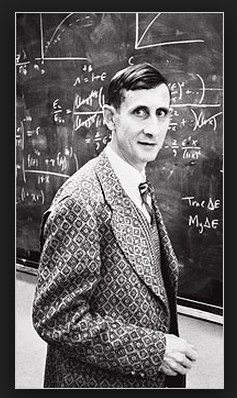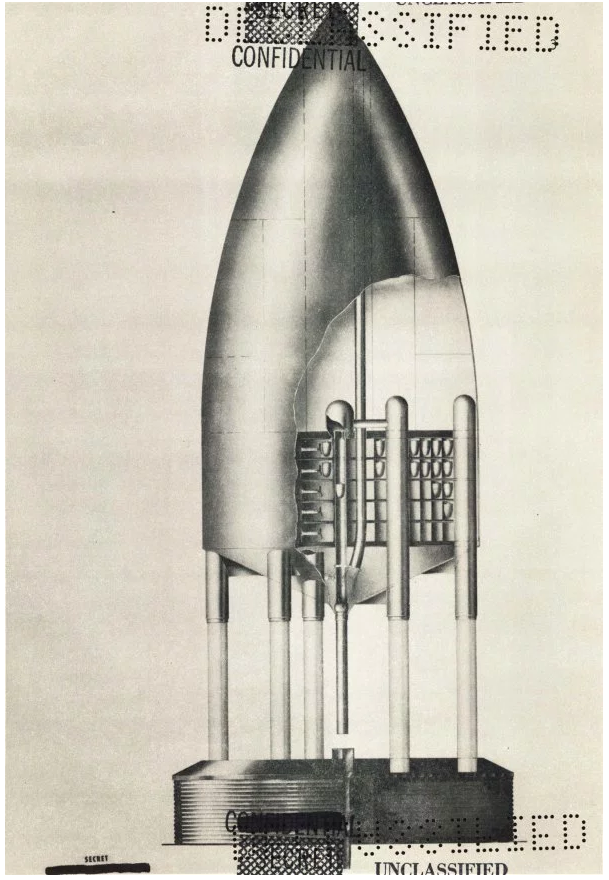The Pipe Dreams of Physicists
"[F]rom all the deceits of the world, the flesh, and the devil, Good Lord, deliver us." (Anglican Book of Common Prayer)
In 1972 London’s Birkbeck College invited British-born physicist Freeman J. Dyson to give the school’s annual Bernal Lecture. The lecture series was named after John Desmond Bernal, an Irish crystallographer and molecular biologist. For his lecture topic, Dyson decided to revisit Bernal's visionary 1929 book about the future called The World, the Flesh, and the Devil.  Bernal’s book gave a succinct exploration of how radical new technologies could help society confront what he called the “three enemies of the rational soul.” Bernal’s first and foremost foe was the World. To transcend the limits of terrestrial resources and the unpredictability of the planet’s environment, he proposed that people expand into the cosmos. In permanent free-floating settlements, “free communication and voluntary associations of interested persons” would prevail, liberating people from earthly traditions and values. To thrive in these new environments, people would be obliged to “interfere in a highly unnatural manner” with the Flesh. For Bernal, this first meant radical surgery, the replacement of organs and tissues with mechanical substitutes, and then the eventual modification of people’s genetic material. However, the Devil, which Bernal defined as our “desires and fears…imaginations and stupidities,” remained a treacherous foe for people who wanted to actively engineer their future.Dyson, like Bernal, had a long-standing interest in the technological future. But his reputation as a physicist was based on his theoretical work on the fundamentals of how light and matter interact at the quantum level. After coming to the U.S. in 1947, he studied physics at Cornell, O'Neill’s alma mater. A year later, physicist Robert Oppenheimer recruited Dyson to the Institute for Advanced Study in Princeton.After Sputnik’s launch in 1957, Dyson took a break from theoretical physics to help design Project Orion, an proposed interplanetary spaceship that would be propelled forward by nuclear explosions. As bizarre as such an effort might seem today, military and NASA funding helped the Orion team build a small (non-nuclear) test version of their space exploration machine. However, the signing of the limited test ban treaty in 1963 and dwindling Air Force interest contributed to Orion’s cancellation in 1965 even though Dyson and others had contributed years of serious design and engineering work. ((George Dyson, Project Orion: The Atomic Spaceship, 1957-1965 (New York: Allen Lane Science, 2002).))
Bernal’s book gave a succinct exploration of how radical new technologies could help society confront what he called the “three enemies of the rational soul.” Bernal’s first and foremost foe was the World. To transcend the limits of terrestrial resources and the unpredictability of the planet’s environment, he proposed that people expand into the cosmos. In permanent free-floating settlements, “free communication and voluntary associations of interested persons” would prevail, liberating people from earthly traditions and values. To thrive in these new environments, people would be obliged to “interfere in a highly unnatural manner” with the Flesh. For Bernal, this first meant radical surgery, the replacement of organs and tissues with mechanical substitutes, and then the eventual modification of people’s genetic material. However, the Devil, which Bernal defined as our “desires and fears…imaginations and stupidities,” remained a treacherous foe for people who wanted to actively engineer their future.Dyson, like Bernal, had a long-standing interest in the technological future. But his reputation as a physicist was based on his theoretical work on the fundamentals of how light and matter interact at the quantum level. After coming to the U.S. in 1947, he studied physics at Cornell, O'Neill’s alma mater. A year later, physicist Robert Oppenheimer recruited Dyson to the Institute for Advanced Study in Princeton.After Sputnik’s launch in 1957, Dyson took a break from theoretical physics to help design Project Orion, an proposed interplanetary spaceship that would be propelled forward by nuclear explosions. As bizarre as such an effort might seem today, military and NASA funding helped the Orion team build a small (non-nuclear) test version of their space exploration machine. However, the signing of the limited test ban treaty in 1963 and dwindling Air Force interest contributed to Orion’s cancellation in 1965 even though Dyson and others had contributed years of serious design and engineering work. ((George Dyson, Project Orion: The Atomic Spaceship, 1957-1965 (New York: Allen Lane Science, 2002).)) In his 1972 lecture, Dyson gave an assessment of Bernal's futuristic ideas (the text of his lecture is here.) He concluded Bernal had been largely on target. ((Dyson’s lecture was published as Freeman J. Dyson, “The World, the Flesh and the Devil,” in Communication with Extraterrestrial Intelligence, edited by Carl Sagan (Cambridge: The MIT Press, 1972), 370-89.)) People had gone into space, artificial organ transplants were now possible, molecular biology was an established field, and knowledge about the workings of the human brain had grown greatly. Even when it came to the Devil, Dyson found Bernal on the mark. In 1972, just as in 1929, there was a “highly vocal and well-organized opposition” to the “further growth of technology” as irrational “social prophets” depicted it as a “destructive rather than liberating force.”In his lecture, Dyson went on to use Bernal’s slim book as a springboard for his own predictions. He suggested that new technologies must be harnessed as allies in the struggle against resource scarcity, overpopulation, and other planetary ills. For example, biological engineering could design novel organisms that could convert “wastes efficiently into usable solids and pure water.” Inorganic “self-reproducing machinery,” analogous to coral and oysters, could collect minerals from the ocean and be another ally in the “attack on Bernal’s three enemies.” Besides ameliorating life on earth, radical bio-engineering could also enable the colonization of space. New life forms such as “Big Trees,” as Dyson called them, could be engineered to grow on comets which had ample amounts of water and nitrogen. The result might be the “greening of the Galaxy” as settlers transformed space into habitable oases.The success of the Apollo era helped shape Dyson’s thinking about the technological future. So did his experiences as a father. His trials as a parent became public knowledge in 1978 with the appearance of popular book written by Kenneth Brower, son of Sierra Club founder David Brower. The Starship and the Canoe chronicled the tensions between the famous physicist who worked at the intersection of science and the military – Freeman Dyson regularly advised on national security issues – and his rebellious son.
In his 1972 lecture, Dyson gave an assessment of Bernal's futuristic ideas (the text of his lecture is here.) He concluded Bernal had been largely on target. ((Dyson’s lecture was published as Freeman J. Dyson, “The World, the Flesh and the Devil,” in Communication with Extraterrestrial Intelligence, edited by Carl Sagan (Cambridge: The MIT Press, 1972), 370-89.)) People had gone into space, artificial organ transplants were now possible, molecular biology was an established field, and knowledge about the workings of the human brain had grown greatly. Even when it came to the Devil, Dyson found Bernal on the mark. In 1972, just as in 1929, there was a “highly vocal and well-organized opposition” to the “further growth of technology” as irrational “social prophets” depicted it as a “destructive rather than liberating force.”In his lecture, Dyson went on to use Bernal’s slim book as a springboard for his own predictions. He suggested that new technologies must be harnessed as allies in the struggle against resource scarcity, overpopulation, and other planetary ills. For example, biological engineering could design novel organisms that could convert “wastes efficiently into usable solids and pure water.” Inorganic “self-reproducing machinery,” analogous to coral and oysters, could collect minerals from the ocean and be another ally in the “attack on Bernal’s three enemies.” Besides ameliorating life on earth, radical bio-engineering could also enable the colonization of space. New life forms such as “Big Trees,” as Dyson called them, could be engineered to grow on comets which had ample amounts of water and nitrogen. The result might be the “greening of the Galaxy” as settlers transformed space into habitable oases.The success of the Apollo era helped shape Dyson’s thinking about the technological future. So did his experiences as a father. His trials as a parent became public knowledge in 1978 with the appearance of popular book written by Kenneth Brower, son of Sierra Club founder David Brower. The Starship and the Canoe chronicled the tensions between the famous physicist who worked at the intersection of science and the military – Freeman Dyson regularly advised on national security issues – and his rebellious son. The book’s narrative eloquently juxtaposed Freeman’s desire to build nuclear-powered spacecraft and live in space with those of his son, George, who was building a giant ocean-going kayak while residing in a towering Douglas fir tree in British Columbia.Dyson had a kindred spirit in thinking about settlements in space. His neighbor was Princeton University physicist and space colony popularizer Gerard O'Neill. Dyson and O'Neill agreed on the merits of human settlements in space, but they differed as to what this humanization of space might look like. “Your standardized prefab communities have a bureaucratic quality which repels me,” Dyson wrote O'Neill. Although “my pipe dreams are different from yours,” Dyson noted that the planet needs “many dreamers and many dreams” from which “fate will make her choice.” Despite their differing views about how the humanization of space might happen, Dyson recalled that his Princeton neighbor revitalized his interest in space exploration.Years later, O'Neill was dying from leukemia. But he was still thinking of visionary technologies - in this case a plan for a super-speed train system called VSE (for velocity, silence, and efficiency). When he was too sick to travel to Washington, DC to present it to scientists at the Department of Energy, Dyson literally gave him a hand, taking O'Neill's plans to the Capital. As he told me an email, "I was desperately sad because I loved both the idea of VSE and Gerry O'Neill, and I knew that both were dying." O'Neill passed away a few weeks later.
The book’s narrative eloquently juxtaposed Freeman’s desire to build nuclear-powered spacecraft and live in space with those of his son, George, who was building a giant ocean-going kayak while residing in a towering Douglas fir tree in British Columbia.Dyson had a kindred spirit in thinking about settlements in space. His neighbor was Princeton University physicist and space colony popularizer Gerard O'Neill. Dyson and O'Neill agreed on the merits of human settlements in space, but they differed as to what this humanization of space might look like. “Your standardized prefab communities have a bureaucratic quality which repels me,” Dyson wrote O'Neill. Although “my pipe dreams are different from yours,” Dyson noted that the planet needs “many dreamers and many dreams” from which “fate will make her choice.” Despite their differing views about how the humanization of space might happen, Dyson recalled that his Princeton neighbor revitalized his interest in space exploration.Years later, O'Neill was dying from leukemia. But he was still thinking of visionary technologies - in this case a plan for a super-speed train system called VSE (for velocity, silence, and efficiency). When he was too sick to travel to Washington, DC to present it to scientists at the Department of Energy, Dyson literally gave him a hand, taking O'Neill's plans to the Capital. As he told me an email, "I was desperately sad because I loved both the idea of VSE and Gerry O'Neill, and I knew that both were dying." O'Neill passed away a few weeks later.